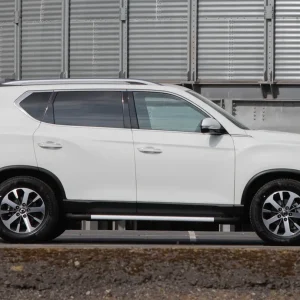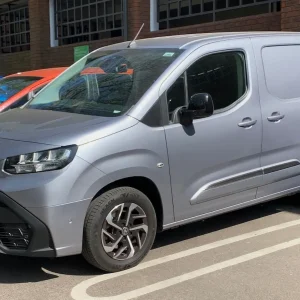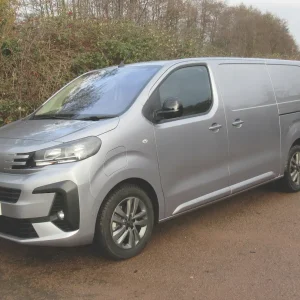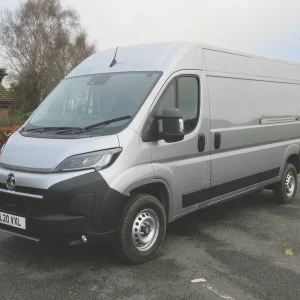You can also buy it as a UK-assembled Vauxhall Vivaro, as a Fiat Professional Talento, which was used by Fiat to replace the ageing Scudo, and as a Nissan NV300. In an attempt to keep what it has to offer distinctive, however, Nissan has redesigned the front end of its offering so that it shares the same styling as certain other models in its range.
They include the NV400, which is – you’ve guessed it – a re-badged and slightly restyled version of Renault’s Master and Vauxhall’s Movano.
The NV300 is up for grabs with a choice of two different nominal gross weights – 2,700kg or 2,900kg – two different body lengths and two different roof heights. Load cubes range from 5.2m3 to 8.6m3, while payload capacities run from 1,075kg to 1,310kg.
Three different trim levels are on offer: Visia, Acenta and Tekna.
Power comes courtesy of a 1.6-litre dCi diesel generating either 95hp or 120hp if you opt for the single-turbocharger version, rising to 125hp or 145hp if you choose the twin variable-geometry turbo. A six-speed manual gearbox is standard in each case.
Available alongside the standard van are crew van, up to nine-seater combi and platform cab variants.
We decided to get to grips with a short-wheelbase standard-roof van nominally grossing at 2,700kg – the true gross weight is a, much higher, 2,820kg – that was powered by the 125hp diesel engine and built to Acenta specifications.
Load bay

If you regularly carry cargo that needs lashing down then this NV300 is the van for you.
Graced by two lights, our demonstrator’s 5.2m3 ply-lined load bay boasted no less than 16 tie-down points including two either side of the rear door and three on each side of the full-height steel bulkhead.
At the bottom of the bulkhead on the passenger side of the vehicle you will find a hatch. Flip it up and latch it into place using the magnetic catch and you can push extra-long items under the passenger seat, increasing the load floor’s useable length from 2,537mm to 2,967mm.
Pull up another hatch in the front of the seat plinth and you can push them all the way through to the footwell – always assuming, of course, that the passengers’ feet don’t get in the way. Doing so boosts the usable length to 3,750mm.
The twin back doors can be latched open at 90°and swung through 165° if you release the user-friendly door stays. The large handles found on all the doors, including the sliding nearside door, make them easy to open and shut when wearing thick working gloves.

Interior and equipment

Legroom for the three-seater cab’s middle passenger is restricted because of the way in which the centre of the dashboard curves outwards. It might be okay for short, local journeys, but not for long-haul trips, and is yet another example of manufacturers trying to squeeze people into accommodation that only really has room for two.
Oddment storage facilities include a capacious lidded glove box, which, unfortunately, cannot be locked, with a shelf above it. They are complemented by two shelves on top of the fascia, one of which plays host to a USB port, and two bins in each of the doors.
As for the all-important cupholders, you will find one at each extremity of the fascia. The third, flip-down one in the middle cannot be used if the centre passenger seat is occupied.
Flip down the back of the centre seat and it turns into a desk complete with another cupholder and a removable A4 clipboard. Pull up the passenger seat cushions and you’ll discover plenty of hidden storage space underneath; just the place to hide your expensive power tools.
Both the steering wheel and the driver’s seat, which has an armrest, are height-adjustable and the wheel can be adjusted for reach.
Our van came with air-conditioning, electric windows and mirrors – the latter are heated and feature a separate, lower, wide-angle section – a multi-function trip computer and a 12V power point in the attractive two-tone light grey/dark grey dashboard. There is one in the load area too. A driver’s airbag is among the other benefits provided, along with a smartphone dock, Bluetooth connectivity, and a digital radio with an aux socket for an MP3 player and remote controls on the steering column.
The NV300 comes with ABS, electronic stability programme, emergency brake assist, electronic brakeforce distribution, hill-start assist and an Extended Grip switchable traction control system that helps drivers cope more effectively with loose surfaces.
Disc brakes are fitted at the front, drums provide the stopping power at the back, and the front fog lights should prove a boon in gloomy winter weather. The reversing sensors are a boon all year round and can be switched off if you feel you really need to.
Engine and gearbox

The four-cylinder 16-valve twin-turbo diesel generates max power at 3,500rpm. Top torque of 320Nm kicks in at 1,500rpm. The sequential turbocharging plus intercooler arrangement the engine relies on is designed to make it more responsive and more frugal at the same time.
Euro6 is achieved through the use of AdBlue – the reservoir holds 20 litres – and a diesel particulate filter is installed.
Driving
While the NV300’s handling may not be quite as competent as the Ford Transit Custom’s, there is no denying that it comes close. The steering tightens up nicely as you punch the van through bends while offering plenty of assistance when you need to wriggle into a tight parking space.
A trek up the M6 left us impressed with its abilities as a high-speed motorway cruiser, with a slick gear change allowing us to nip briskly from one set of cogs to the next as the level of traffic ebbed and flowed. Acceleration from rest and up through the gears is strong, noise levels are kept well under control, and the ride copes well with the varying quality of road surfaces.
Our NV300 came complete with a blind spot mirror mounted in the passenger sun visor, which should help you see cyclists creeping up on your nearside in busy urban traffic and avoid knocking them over. If you have a passenger with you, however, then they are unlikely to be happy about staring into it mile after mile and are likely to flip the visor up unless the sunshine happens to be really bright.
Vivaro’s suspension employs independent MacPherson struts at the front while a five-link set-up helps deliver support at the back.
Our Nissan’s 16-inch steel wheels were shod with 205/65 R16C Goodyear Marathon tyres – a full-size spare is provided – and decorated with plastic trims. Power-assisted rack-and-pinion steering offers a 11.8m kerb-to-kerb turning circle expanding to 12.4m wall-to-wall.
Operating

A stop/start system that kills the engine if it is allowed to idle wastefully at the lights or in a traffic jam should help keep fuel consumption and CO2 emissions down. All you need to do to start the engine again is dip the clutch. The system can be switched on and off using a button on the dashboard.
Press the Eco button on the gearbox console and you immediately decrease engine power and alter throttle pedal response. By doing so you make little noticeable difference to your on-the-road performance if you are unladen or lightly laden but can enjoy up to 10% better fuel economy. The only time you may struggle is if you are tackling a steep hill fully laden.
Permanently functioning is Smart Energy Management, which recovers energy every time you brake or decelerate. It too helps minimise fuel usage. Quoted fuel consumption is 47.9mpg on the official combined cycle. We averaged closer to 44.0mpg with extensive use of the Eco button on motorway journeys.
An alarm is fitted and side rubbing strips help protect the paintwork from minor damage.
The manufacturer is to be praised for the comprehensive warranty package it has assembled – a key reason for putting the NV300 on your shopping list.
It is protected by a five-year/100,000-mile warranty with roadside assistance provided for the duration. The paintwork warranty lasts for five years too, while the anti-perforation corrosion guarantee lasts for 12 years.
Service intervals are set at two years/25,000 miles and in our view should be complemented by interim safety checks, especially if the van is working in an arduous environment.
Nissan NV300 L1H1 125 2700 Acenta
Price (ex VAT) £23,455
Price range (ex VAT) £21,015-£28,210
Gross payload 1,081kg
Load length 2,537mm
Load width (min/max) 1,268/1,662mm
Load bay height 1,387mm
Load volume 5.2m3
Loading height 552mm
Rear door aperture 1,320×1,391mm
Side door aperture 1,284×1,030mm
Gross vehicle weight 2,820kg
Braked trailer towing weight 2,000kg
Residual value 15.3%*
Cost per mile 46.0p
Engine size/power 1,598cc, 125hp @ 3,500rpm
Torque 320Nm @ 1,500rpm
Gearbox 6-speed
Fuel economy 47.9mpg
Fuel tank 80 litres
CO2 155g/km
Warranty 5yrs/100,000mls
Service intervals 2yrs/25,000mls
Insurance group 37
Price as tested £24,085
(* after 4yrs/80,000mls – source: KwikCarcost)
Options fitted: Ply lining (£630)

Rivals
Ford Transit Custom
- Price (ex VAT)£20,395-£31,545
- Load volume 6.0-8.3m3
- Gross payload 674-1,474kg
- Engines 105hp, 130hp, 170hp 2.0 diesel
Verdict: The van to beat in this sector of the market is Ford’s all-conquering Transit Custom, and beating it is going to be a big ask for any manufacturer. Performance, ride and handling are all class-leading, residuals are to die for and it is now on offer with an auto gearbox. Facelifted models goes on sale early next year with a plug-in hybrid due for 2019.
Peugeot Expert
- Price (ex VAT£18,745-£27,795
- Load volume 4.6-6.1m3
- Gross payload 1,099-1,499kg
- Engines 95hp, 115hp 1.6 diesel, 120hp, 150hp, 180hp 2.0 diesel
Verdict: Once again the badge engineers are in the ascendancy, with Peugeot’s Expert also available through Citroen dealers as the Dispatch and through Toyota dealers as the Proace. A big improvement on its elderly predecessor, it’s a well-thought-out package boasting most of the facilities the driver is likely to need.
Volkswagen Transporter
- Price (ex VAT) £19,290-£38,920
- Load volume 5.8-9.3m3
- Gross payload 718-1,274kg
- Engines 84hp, 102hp, 150hp, 204hp 2.0 diesel
Verdict: Look beyond the uninspiring internal and external styling and you will discover a van that sets a praiseworthy standard of safety and is rewarding to drive at almost all levels. Built to an extraordinarily high standard that gives you the impression that it will last forever, the Transporter remains a cost-effective workhorse.





